
Research Topics
Dr. Lee develops methods and tools to estimate radiation dose from medical exposures, including treatment and diagnostic tests, in order to generate reliable data for use in epidemiological studies of ionizing radiation and cancer risk.
Computational Human Phantoms
There are two broad approaches to determine organ doses to portions of the human body exposed to ionizing radiation: measurement and calculation. Although measurement can provide dose estimates in actual radiation exposure settings, it is not practical to perform a large number of measurements for all study subjects in epidemiologic studies, because the process is usually time-consuming, expensive, and inflexible.
Alternatively, organ doses can be calculated using a computer simulation of the human body (called a computational human phantom) and radiation exposure scenarios combined with Monte Carlo radiation transport techniques. Dr. Lee has developed a series of computational human phantoms that are crucial for realistic, individualized dose reconstruction. His pediatric series of phantoms has been adopted by the ICRP as the international reference model. To estimate more accurate doses, Dr. Lee, in collaboration with the University of Florida, has expanded the computational phantoms include non-reference body sizes utilizing a library of body dimensions representative of the U.S. population.
Dosimetry for Therapeutic Radiation Procedures
Quantitative estimation of the risk of developing second cancers related to radiotherapy relies on the quality of the dose estimates to normal tissues. However, there are substantial difficulties in reconstructing organ doses for a large cohort of patients treated years ago. Dr. Lee initiated a research consortium with several universities and clinical centers to develop new dose reconstruction methods for external x-ray radiotherapy using Monte Carlo simulation of radiotherapy machines coupled with his computational human phantoms. He calls this combination the National Cancer Institute dosimetry system for Radiation Treatment (NCIRT). He is applying NCIRT to multiple epidemiological studies of second cancers in radiotherapy patients in collaboration with REB epidemiologists as well as the research consortium. Dr. Lee is also extending NCIRT to include dosimetry methods for proton therapy patients.
Dosimetry for Diagnostic Radiation Procedures
Approximately 10 percent of all computed tomography (CT) examinations in the U.S. are performed on pediatric patients, who are at higher risk of radiation-related cancer compared to adults. In order for radiologists to weigh the benefit-harm of conducting such exams, they need a better understanding of the nature and magnitude of the associated health risks. To generate the necessary data to inform such decisions, Dr. Lee has been developing the National Cancer Institute dosimetry system for Computed Tomography (NCICT), based on Monte Carlo simulation combined with computational human phantoms. To validate the organ dose calculated from NCICT he compared it with data collected from experiments using physical anthropomorphic phantoms and radiation dosimeters. The software itself has been tested by more than 100 beta testers and utilized for multiple epidemiological studies of CT risk. NCICT is being made available to the scientific community in conjunction with the NCI Technology Transfer Center. Dr. Lee is also developing dosimetry methods and tools for other diagnostic radiation procedures including radiography, fluoroscopically-guided interventional procedures, and nuclear medicine practices.
Biography
Dr. Lee received a Ph.D. degree in health physics in 2002 from Hanyang University in South Korea. He subsequently joined the Innovative Technology Center for Radiation Safety in South Korea as a postdoctoral fellow, and later completed extensive training in computational medical physics as a postdoctoral researcher at the University of Florida. Dr. Lee joined the Radiation Epidemiology Branch (REB) as a tenure-track investigator in 2009, and was awarded scientific tenure and promoted to senior investigator in September 2016 and named Head of REB’s Dosimetry Unit. Dr. Lee is a full member on two task groups of the International Commission on Radiological Protection (ICRP). He also serves on the editorial board of Radiation Protection Dosimetry.
Selected Publications
- Lee C, Kim KP, Long DJ, Bolch WE. Organ doses for reference pediatric and adolescent patients undergoing computed tomography estimated by Monte Carlo simulation. Med Phys. 2012;39(4):2129-46.
- Kim KP, Berrington de González A, Pearce MS, Salotti JA, Parker L, McHugh K, Craft AW, Lee C. Development of a database of organ doses for paediatric and young adult CT scans in the United Kingdom. Radiat Prot Dosimetry. 2012;150(4):415-26.
- Lamart S, Imran R, Simon SL, Doi K, Morton LM, Curtis RE, Lee C, Drozdovitch V, Maass-Moreno R, Chen CC, Whatley M, Miller DL, Pacak K, Lee C. Prediction of the location and size of the stomach using patient characteristics for retrospective radiation dose estimation following radiotherapy. Phys Med Biol. 2013;58(24):8739-53.
- Lee C, Lamart S, Moroz BE. Computational lymphatic node models in pediatric and adult hybrid phantoms for radiation dosimetry. Phys Med Biol. 2013;58(5):N59-82.
- Lamart S, Bouville A, Simon SL, Eckerman KF, Melo D, Lee C. Comparison of internal dosimetry factors for three classes of adult computational phantoms with emphasis on I-131 in the thyroid. Phys Med Biol. 2011;56(22):7317-35.
Related Scientific Focus Areas
This page was last updated on Thursday, July 24, 2025

